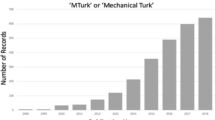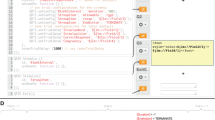Abstract
DMDX is a software package for the experimental control and timing of stimulus display for Microsoft Windows systems. DMDX is reliable, flexible, millisecond accurate, and can be downloaded free of charge; therefore it has become very popular among experimental researchers. However, setting up a DMDX-based experiment is burdensome because of its command-based interface. Further, DMDX relies on RTF files in which parts of the stimuli, design, and procedure of an experiment are defined in a complicated (DMASTR-compatible) syntax. Other experiment software, such as E-Prime, Psychopy, and WEXTOR, became successful as a result of integrated visual authoring tools. Such an intuitive interface was lacking for DMDX. We therefore created and present here Visual DMDX (http://visualdmdx.com/), a HTML5-based web interface to set up experiments and export them to DMDX item files format in RTF. Visual DMDX offers most of the features available from the rich DMDX/DMASTR syntax, and it is a useful tool to support researchers who are new to DMDX. Both old and modern versions of DMDX syntax are supported. Further, with Visual DMDX, we go beyond DMDX by having added export to JSON (a versatile web format), easy backup, and a preview option for experiments. In two examples, one experiment each on lexical decision making and affective priming, we explain in a step-by-step fashion how to create experiments using Visual DMDX. We release Visual DMDX under an open-source license to foster collaboration in its continuous improvement.





Similar content being viewed by others
Notes
Alternatively, if you want DMDX to scramble the items for each participant dynamically, you have to add previously explained scrambling keywords manually (i.e., Scramble, ScrambleSeed, Grouping).
References
Birnbaum, M. H. (2000). SurveyWiz and FactorWiz: JavaScript Web pages that make HTML forms for research on the Internet. Behavior Research Methods, Instruments, & Computers, 32, 339–346.
Fazio, R. H. (2001). On the automatic activation of associated evaluations: An overview. Cognition and Emotion, 15, 115–141.
Fazio R. H., Russell H., David M. Sanbonmatsu, Martha C. Powell, and Frank R. Kardes (1986). On the Automatic Activation of Attitudes. Journal of Personality and Social Psychology 50, 229–238.
Forster, K. I., & Forster, J. C. (2003). DMDX: A Windows display program with millisecond accuracy. Behavior Research Methods, Instruments, & Computers, 35, 116–124.
Free Software Foundation. (2007). GNU Affero General Public License, version 3.0. Retrieved December 18, 2013 from: http://www.gnu.org/licenses/agpl-3.0.html
Freelon, D. (2010). ReCal: Intercoder reliability calculation as a Web service. International Journal of Internet Science, 5, 20–33.
Freelon, D. (2013). ReCal OIR: Ordinal, interval, and ratio intercoder reliability as a web service. International Journal of Internet Science, 8, 10–16.
Garaizar, P., & Reips, U.-D. (2013). Build your own social network laboratory with Social Lab: A tool for research in social media. Behavior Research Methods. doi:10.3758/s13428-013-0385-3. Advance online publication.
Göritz, A. S., & Birnbaum, M. H. (2005). Generic HTML Form Processor: A versatile PHP script to save Web-collected data into a MySQL database. Behavior Research Methods, 37, 703–710.
Jiang, N. (2012). Conducting reaction time research in second language studies. New York: Routledge.
Klauer, K. C., & Musch, J. (2003). Affective priming: Findings and theories. In J. Musch & K. C. Klauer (eds.), The psychology of evaluation: Affective processes in cognition and emotion (pp. 7–50). Mahwah, NJ: Erlbaum.
Krantz, J. H. (2000). Tell me, what did you see? The stimulus on computers. Behavior Research Methods, Instruments, & Computers, 32, 221–229.
Mathôt, S., Schreij, D., & Theeuwes, J. (2012). OpenSesame: An open-source, graphical experiment builder for the social sciences. Behavior Research Methods, 44, 314–324.
Peirce, J. W. (2007). PsychoPy: Psychophysics software in Python. Journal of Neuroscience Methods, 162, 8–13.
Reips, U.-D. (2001). The Web Experimental Psychology Lab: Five years of data collection on the Internet. Behavior Research Methods, Instruments, & Computers, 33, 201–211.
Reips, U.-D. (2010). Design and formatting in Internet-based research. In S. Gosling & J. Johnson (Eds.), Advanced methods for conducting online behavioral research (pp. 29–43). Washington, DC: American Psychological Association.
Reips, U.-D., & Funke, F. (2008). Interval level measurement with visual analogue scales in Internet-based research: VAS Generator. Behavior Research Methods, 40, 699–704.
Reips, U.-D., & Garaizar, P. (2011). Mining Twitter: Microblogging as a source for psychological wisdom of the crowds. Behavior Research Methods, 43, 635–642.
Reips, U.-D., & Lengler, R. (2005). The Web Experiment List: A Web service for the recruitment of participants and archiving of Internet-based experiments. Behavior Research Methods, 37, 287–292.
Reips, U.-D., & McClelland, G. (2013). Interactive applets on the Web for methods and statistics. University of Amsterdam, AIAS Working Paper 132.
Reips, U.-D., & Neuhaus, C. (2002). WEXTOR: A Web-based tool for generating and visualizing experimental designs and procedures. Behavior Research Methods, Instruments, & Computers, 34, 234–240.
Schneider, W., Eschman, A., & Zuccolotto, A. (2002). E-Prime user’s guide. Pittsburgh, PA: Psychology Software Tools.
Stieger, S., & Reips, U.-D. (2008). Dynamic Interviewing Program (DIP): Automatic online interviews via the instant messenger ICQ. CyberPsychology and Behavior, 11, 201–207.
Stieger, S., & Reips, U.-D. (2010). What are participants doing while filling in an online questionnaire: A paradata collection tool and an empirical study. Computers in Human Behavior, 26, 1488–1495.
Wentura, D., & Rothermund, K. (2007). Paradigms we live by: A plea for more basic research on the IAT. In B. Wittenbrink & N. Schwarz (eds.), Implicit measures of attitudes (pp. 195–215). New York: Guilford Press.
Author note
We thank Julen Telleria for assistance in coding. Support for this research was provided by Grant PSI2011-26965 from Dirección General de Investigación of the Spanish Government and Grant IT363-10 from the Basque Government. The authors declare that there was no conflict of interest in the publication of this study.
Author information
Authors and Affiliations
Corresponding author
Rights and permissions
About this article
Cite this article
Garaizar, P., Reips, UD. Visual DMDX: A web-based authoring tool for DMDX, a Windows display program with millisecond accuracy. Behav Res 47, 620–631 (2015). https://doi.org/10.3758/s13428-014-0493-8
Published:
Issue Date:
DOI: https://doi.org/10.3758/s13428-014-0493-8




